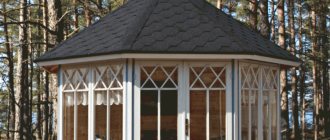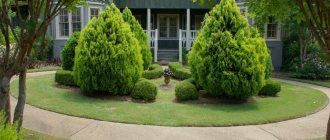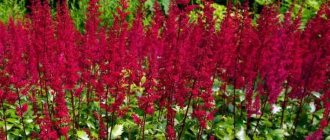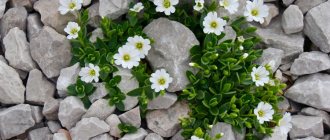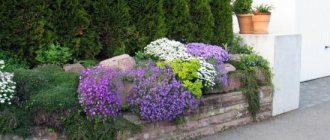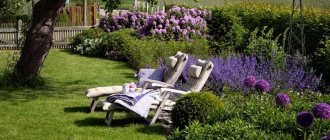Features of plants for decoration
Grasses from several genera are considered ornamental - Grassaceae, Cataceae, Ruminaceae and Sedgeaceae. In total, there are at least 10,000 herbs used in landscape design in the world. They are valued for their elegant spikelets, which have a special sound when the wind blows.
Both annuals and perennials have their rightful place. A wide selection of options will help to decorate any garden in an unusual way and make it unique in any month of the year. For example, in the spring they will delight the eyes with lush greenery, in the summer they will have beautiful panicles.
In the fall, different varieties of grass can paint the area in different colors, and in the winter, some types will also add charm.
Cereals
An excellent way to demonstrate the beauty of a garden plot. They serve as an ideal basis for the central areas of the garden, attracting attention with their sophistication.
Cereals with a height of more than 1 meter are classified as tall plants. They are used for background designs with multi-level plantings or as independent flower bed combinations.
Ornamental grass crops with sizes from 0.5 to 1 meter are classified as medium-sized species. They are used in mixborders and multi-tiered flower beds. The most common plants of medium height are feather grass, oats, and falaris.
Low-growing ornamental crops, the height of which is no more than 0.5 meters, are used in small front gardens to decorate flower beds and lawns.
Low plants can form either independent compositions or serve as an excellent addition to plantings. The most common small plants are heather, barley, haretail and others.
Kaleria gray
It is recommended to provide it with dry soil mixed with sand. It does not feel very comfortable in damp conditions, so drainage during sowing is very desirable. This is a perennial representative of Cereals that can reproduce by seeds and division.
It is not afraid of wintering, and the height of the leaves reaches 15 cm. You can use it as part of an alpine hill or sow it alone.
Ornamental grasses for the garden
Thanks to cereals, the space literally comes to life, acquiring dynamics and sound. Light airy grass will begin to dance with wave-like movements at the slightest sway of the wind. And the graceful spikelets will begin to whisper among themselves, allowing you to listen to their secrets.
What cereals to plant on the plot
Feather grass
Among the popular perennials, I would like to mention feather grass, for example, its feathery and finest types. These are the most unpretentious varieties for mid-latitudes. Well-drained, non-acidified soil is suitable for feather grass. Gardeners value feather grass for its decorative properties. Propagated both by seeds and by dividing the bush.
Feather grass
Gray fescue
The compact bushes of this plant will decorate any flower bed. Designers love it for its unusual color and unpretentiousness. Gray fescue easily tolerates frost and loves sunny places, does not tolerate stagnant moisture. It can be propagated either by seeds or by dividing the bush.
Gray fescue
Hairy cirrus bristle
Loves warm climates and grows easily. If it is not possible to provide shelter from frost in a greenhouse for the winter, it can be grown as an annual cereal. Reproduction methods: seeds and division. Fluffy spikelets of the hairy pinnate bristle will decorate your flower garden.
Hairy cirrus bristle
Maned barley
A perennial grass that is often grown as an annual plant. It does not tolerate frost. It forms bushes up to half a meter high, dense, with spikelets of inflorescences on the shoots. During flowering they are pink-violet, turning white over time. In mild winters it can survive and self-sow well.
Maned barley
Ornamental grasses are attractive at any time. In spring they spread out like an emerald carpet or appear as small islands among the first flowers. In summer, fancy panicles create coziness. And in the fall, cereals change their colors to warmer tones, saturating the garden with bright colors.
Field fescue
Perfect for dry summer conditions. One sowing can be grown for up to 4 years, after which it is uprooted and sown “from scratch”, because the plants lose their appearance and degenerate.
To renew, you can cut fresh spikelets and throw them from below. After new blades of grass grow from them, they are replanted, and the old bushes are completely removed.
Molinia
- Distinctive features: many bare stems, leaves located exclusively at the base, large diameter of the bush
- Parameters: the minimum height is 0.4 meters, and the maximum is 2 m.
Bright green molinia is a real country fashionista. This lush ornamental grass is presented in a flowerbed with a “bouquet” of beautiful bare stems. Depending on the variety and variety of molinia, they can be either plain or variegated - with an edge.
Molinia blooms for 60 days. This period begins in mid-July and continues until the middle, or even the end of the first autumn month. The panicle, which represents the “flower” of molinia, is located at the top of the bush. This ornamental grass is usually propagated by dividing the bush. But in principle, if you have plant seeds, you can grow molinia this way. However, professionals do not recommend sowing molinia directly into open ground. It is better to use small pots for this. Sow in mid-spring, and transplant the bush to a permanent place only after its root system has become stronger.
Molinia does not need any feeding or watering. The only thing she would like to get is a location in openwork partial shade on fertile and moist soil.
There are sports that are impossible without grass. Baseball and golf are prime examples of this. The world's most expensive sports turf is located in Foggy Albion. The Wimbledon tennis court (and that's what we're talking about here) is seeded with perennial ryegrass.
Miscanthus chinensis
This is one of the favorite cereal plants for decorating a personal plot.
This perennial can reach a height of 1.5 meters. Its leaves are narrow and have white stripes along the edges. Outwardly, it somewhat resembles a fountain formed by leaves. Flowering is observed at the end of summer in the form of red panicles, which gradually turn brown. When planting in autumn, it is advisable to insulate it for the winter. There are no special requirements for the soil.
Types and varieties of ornamental grasses for the garden
Before purchasing seeds of ornamental cereals, you should take into account all the nuances - the design idea, climatic conditions, lighting of the site and soil characteristics. Photos will help you appreciate the beauty of these plants. One of the main criteria when choosing is the height of the plants.
Tall varieties
To decorate areas, tall plants are used less often than others. Most often they serve to create a background or as a screen for different areas of the territory. The height of such ornamental grasses reaches one meter or more.
Acute reed grass
The height of the reed grass is 1.5 m and above. It differs from others in that it is not picky about soils. Grows well even in heavy clay soil. Characterized by:
- rapid growth;
- drought resistance;
- unpretentiousness to light (can be planted both in bright sun and in the shade).
When planting this cereal on a plot, it should be taken into account that it has a creeping rhizome, which compacts the soil, causing its top layer to harden.
Pennisetum glaucosa (Millet millet)
This plant is an annual with an interesting burgundy-bronze hue. It grows up to 1.5 m, which allows it to be used both in flower arrangements and planted in separate flower beds.
High pearl barley
An ornamental grass, reaching 1.5 m, has purple inflorescences. Often used as a background for yellow and orange flowers. It takes root very well on any soil, tolerates dampness and lack of direct sunlight.
Miscanthus saharaflower
An original plant that grows as tall as a man and has the appearance of a mound-shaped hummock. This ornamental grass blooms profusely in August-September.
Reed dvuhistochnik (flyaris)
A very unpretentious grass that can take root on any type of soil, grows up to 1.5 m. It tolerates dry, windy and rainy weather, direct sunlight and partial shade. But it feels best in the shade and in moist soil.
Low-growing species
This type of decorative grasses has a wide range of applications - designing the foregrounds of flower arrangements, borders, stone slides, rock gardens and rockeries. Most often they do not grow above 40 cm.
Meadow foxtail
Meadow foxtail
The perennial, reaching a height of 30 cm, has an unusual golden color of leaves and soft inflorescences in the form of spikelets. It does not crush other plants, as it does not grow to large sizes. The period of active flowering occurs in mid-summer.
Gray fescue
Gray fescue
It has a bush-like shape, needle-shaped leaves of blue shades and red paniculate inflorescences. It grows up to 20 cm and is used to decorate small flower beds and stone slides. It does not tolerate the absence of sun, so it should be planted in brightly lit areas of the site.
Bulbous ryegrass
Bulbous ryegrass
This ornamental grass is a perennial, reaching 30 cm in height. It is distinguished by an unusual type of foliage - very narrow, green in color with a whitish tint.
Winding meadow
Winding meadow
Despite the fact that meadow grass grows very slowly, due to its original appearance, it is very popular among gardeners. The leaves of this cereal are very thin, like hair, and have a rich yellow color. Inflorescences of lighter shades are located on a thin stalk. The period of active flowering occurs at the end of May-June.
Keleria gray
Keleria gray
A very low plant (no more than 10 cm) looks like a hummock consisting of hard leaves. Most often used to decorate rockeries and stone slides. Does not freeze even in very cold weather. It is demanding about watering - the soil should not be allowed to dry out.
Unpretentious varieties of cereals
Unpretentious varieties of cereals
There are varieties of ornamental cereals that can be planted in any climatic conditions, on any soil, and do not require a special approach to care.
- Feather grass. Tolerates any weather conditions well. Perennial, with thin stems shimmering in golden color. It has a large number of varieties of different heights and shapes.
- Blue fescue. An adult plant forms a small cone-shaped bush with narrow leaves of a delicate blue color. Does not require shelter when cold weather sets in and gets along well with other plants, especially conifers.
- Molinia. Tall bushy plant with small inflorescences. It has a unique color that changes throughout the day. This cereal is especially beautiful in the rays of the setting sun.
- The pike is turfy. A very tenacious ornamental grass that tolerates good proximity to other plants. It can be planted in both shaded and brightly lit areas. Tolerates winter cold well without additional insulation.
Warm-season cereals
There are also varieties of ornamental grasses that will not grow in cold soil. To plant them, it is required that it warms up to 26°C. They grow very slowly and bloom late (only in mid-summer), but they retain their decorative qualities until the beginning of autumn.
Rogoz
This grass is often used to strengthen the banks of artificial reservoirs. Before planting, the soil must first be prepared. To do this, prepare a mixture of different types of soil - gravel, clay and sand. This will prevent water from washing out the roots of the plant and will ensure long and active growth.
Switchgrass
This cereal can be planted in any soil in a brightly lit area. Growing up takes quite a long time. It begins to bloom in August-September. When planting, you should take into account its ability to self-sow, so you will need to periodically remove excess plants. For the same reason, it can “crush” plants growing next to it.
Spartina comb
A very tall (up to 2 m) perennial plant that grows best in moist soil in a well-lit area. The grass blooms in August with inflorescences in the form of brown panicles. Used to decorate flower arrangements, artificial ponds and lawns.
Southern reed
One of the tallest ornamental grasses, which can reach a height of 5 m. Most often used for zoning a garden plot. A very viable plant that tolerates both dry and wet weather. Its main feature is that it does not produce inflorescences every year.
Southern reed
Kolosnyak
It will look good as a single bush or as a border. Goes well with lilies. It is painted gray and retains its shape well. The disadvantage is its rapid growth, which can be combated by fencing the grass with slate or planting it in a container without a bottom.
Decorative millet
This is an annual that has beautiful leaves that are purple-brown in color and wide. Small shoots are green with a purple border. The grown plant looks like a reed.
An unusual inflorescence appears in mid-summer, and by August white specks of dust appear on it. Looks great until the first frost.
What types of ornamental grass are there?
In landscape design, ornamental plants are plants that belong to different families, but have similar external characteristics. Among them: long leaves of a narrow shape, the veins of which are located in parallel; inflorescences in the form of a spike or panicle, attracting with lightness and grace. Such crops decorate the garden almost all year round, being especially attractive after frost. In addition, these plants are undemanding in care and easily get along with other types of garden crops.
Landscape design specialists use them to create natural gardens - imitated corners of nature, where ornamental plants of various types are located in natural disorder.
When it comes to ornamental grasses, the following types are distinguished among them (Figure 1):
- Short (30-50 cm);
- Medium (50-100 cm);
- Tall specimens (above 2 m).
Figure 1. Types of ornamental grasses (from left to right): low-growing, medium-growing and tall-growing
Each of these species has its own characteristics of planting, growing and care, which will be discussed below.
Description of species
Low-growing varieties are suitable for decorating any flower bed, giving it a natural look. They have the ability to grow quickly, so they often have to be confined to fences or containers without a bottom. Among the low-growing species, the most popular are: gray fescue, crested caleria, tortuous meadow grass, and gray-gray thin-legged fescue (Figure 2).
Figure 2. Low-growing plants for the garden: 1 - gray fescue, 2 - thin-legged fescue, 3 - tortuous meadow
Medium-height crops are used to create multi-tiered flower beds. Representatives of this group are feather grass, phalaris canarian, oats, and pinnately bristle. These crops get along well and look great with field poppies, daisies, cornflowers and salvia (Figure 3).
Figure 3. Examples of medium-growing varieties: 1 - feather grass, 2 - phalaris, 3 - pinnately bristle.
Tall specimens are a chic addition to the landscape. They are used not only for garden compositions (screens, screens, backgrounds), but also for independent growth. They are most attractive when they bloom in the summer, and in winter and autumn they enchant with their beautiful leaves. The tall ones include: turfgrass, canary grass, blue molinia, miscanthus, as well as all kinds of subspecies of pennisetum (Figure 4).
Landing rules
You should know that ornamental grasses and grains for the garden grow best in poor soils, so there is no need to apply fertilizers to the area intended for planting them.
Note: Excessive amounts of nutrients in the soil lead to excessive growth of bushes, as a result of which they no longer hold their shape and fall apart.
Soil moisture is of decisive importance when choosing a site for planting, since among herbaceous cereals there are those in which, with an excessive level of moisture, the roots begin to rot, affecting the growth and appearance of the crop (fescue, imperata cylindrical, reed grass, sand grass). On the contrary, species such as sedge, miscanthus, reed, falaris, and calamus grow well in damp areas. Remember that all plants in the same area should have similar requirements for growing conditions.
Figure 4. Tall plants for the garden: molinia, 2 - canary grass, 3 - miscanthus
You can prepare the site for planting both in the fall and in the spring. The selected area should be cleared of weeds and plant debris and dug deep. The dug up earth is leveled and marked, outlining a place for each plant using sand. In this case, the size of an adult bush should be taken into account. Having made the markings, you can begin planting seedlings or sowing seeds. You should be aware that many grasses grow quickly, so it is necessary to provide ways to curb their growth, for example, strips of slate dug into the ground, or plastic containers for particularly aggressive species.
Feather grass
An undemanding grass characterized by a disheveled “mane.” It does not clog the soil underneath, does not have creeping roots and, if necessary, can easily be pulled out of the ground. For 2-3 years you don’t have to worry about the beauty of the garden bed, but then it is recommended to replant it.
How to grow
It is easy to get confused among the many names of ornamental grass. However, you need to know for sure whether it is suitable for your climatic conditions. They may need to be covered for the winter. After all, many species were brought from tropical and subtropical countries, where winters are much warmer than in the central zone, and even more so to the north. Usually all the required information is written on the packaging.
With proper care, the climate should not create any problems.
There are unpretentious varieties that should not be sown directly into the garden. First, this ornamental grass in pots must get stronger, and then it can be planted. Otherwise, large plants can drown it out. Some species can be planted not only from seeds, but also by dividing the roots.
Cold-resistant varieties are characterized by early growth after the snow melts. If transplantation or seating is required, it is worth carrying out these procedures in early spring or in September-October. An important condition is the air temperature is no more than +20 Celsius.
How to plant ornamental grass and cereals
Grasses, sedges and rush plants have different attitudes towards soils and illumination: some love bright light, others prefer forest twilight. Some prefer:
- acidic and damp soils,
- others are loose and rich in humus,
- others are dry sandy or rocky,
- the fourth are chalk.
All this must be taken into account when choosing cereals and herbs for the site, so that later you don’t have to be upset when, instead of what looked like a lush bush on the label, a pathetic tail grows, looking like a weed. In order not to make a mistake and buy seeds of ornamental grasses that do not tolerate long winters and severe soil freezing, do not forget in which climate zone you live.
What are the pros and cons
In the wild, they are excellent at preventing soil erosion. Their excellent property is excellent survivability even in an unfavorable place. Equally important is the ability to design flower beds with different heights of grass.
But there is one drawback - they tend to grow strongly. However, this can be easily stopped by physically blocking the path of the roots (using borders or buried slate) and weeding the surrounding areas. And if that doesn't suit you, consider options with artificial ornamental grass.
If you compare cereals and other types of plants, the former are an excellent choice, because There will be significantly less hassle with them. And they can delight you for up to 3-5 years in one place (the growth period depends on the type of grass).
Cereals
Last, but not least important, on our list are the cereal grasses. They are needed if you need perennial ornamental grass for your garden, but not a lawn, something more noticeable and voluminous.
Cereals are very often found in ordinary fields in the wild. Most of them were initially considered wild, but thanks to landscape designers, many families were domesticated and began to be used on private plots around the world.
First of all, cereal grasses are needed in order to make the entire area more alive, organic, and natural.
The beauty of such plants is that they can grow almost anywhere, thanks in part to the conditions from which they were originally removed. This applies to care, fertilizers, moisture. The same story applies to climatic conditions - heat, rain, frost.
Let's return to the topic of perennial grass. The thing is that most cereals are annual grasses that need to be sown anew every year, just like their cultivated counterparts.
They are considered decorative only because they are not suitable for harvesting. If this option does not suit you, you may instead need decorative grass in pots, which can be kept outside in the summer and moved indoors when frost sets in.
Cereal ornamental grasses come in a variety of varieties - some of them can reach a height of about 2 meters, which is quite a lot, because many ornamental shrubs and trees are lower.
With tall plants, it is important to understand how to use them correctly, place them in relation to other plants and on the site as a whole.
Tall cereal grasses look great in the center of the flowerbed, when near them, around, there are various flowers, preferably not very tall.
In addition to seeds, cereal ornamental grasses can be planted from seedlings or even entire bushes can be replanted. Such plants are usually perennial, and therefore, being in the same place, every year they will become stronger and stronger.
Another important role of these grasses is that they can provide natural protection for nearby flowers from the hot summer sun.
Light-colored herbs are especially suitable for this role, perhaps even with white leaves, which will not only provide shade, but will not suffer too much from constant sun.
Photo of ornamental grass
Total
Category: Lawns and paths
